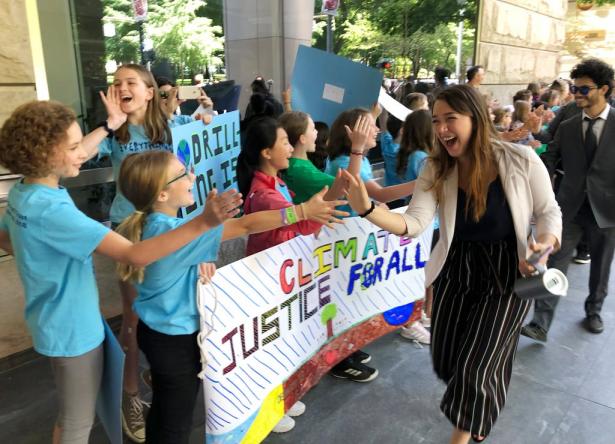Three federal judges heard arguments Tuesday about whether young people have a constitutional right to be protected from climate change. In the lively, hourlong hearing, the judges, from the Court of Appeals for the Ninth Circuit, pushed skeptically on the arguments of both sides.
The closely watched lawsuit, Juliana v. United States, was scheduled to begin last October, but the court granted the Trump administration an unusual pretrial appeal. Their decision could have important implications for this and other attempts to use the courts to pursue climate action across the United States.
A brief filed by the plaintiffs in the case demands that the government step up to protect today’s children, and future generations, from the worst effects of climate change. It says they risk being deprived of their “rights to life, liberty, property, and public trust resources by federal government acts that knowingly destroy, endanger, and impair the unalienable climate system that nature endows.”
The federal government wants the case dismissed before it can even go to trial, but the brief argues that “These young people deserve that chance to present their full case against those who through their governance harm them, and let the light of justice fall where it may.” The plaintiffs have also asked the government to put the brakes on new fossil fuel extraction projects while the case is pending.
Lawyers for the Trump administration have argued in their legal filings that the young people’s “misguided” case is fatally flawed and that “there is no fundamental constitutional right to a ‘stable climate system.’” What’s more, the government argues, the plaintiffs’ proposed solution is unworkable and unconstitutional, “essentially placing a single district court in Oregon — acting at the behest of a few plaintiffs with one particular perspective on the complex issues involved — in charge of directing American energy and environmental policy.”
The three judges on the panel, which was held in Portland, Ore., were Mary H. Murguia and Andrew D. Hurwitz of the Ninth Circuit Court of Appeals, and Josephine L. Staton of District Court for the Central District of California. All three judges were appointed to their current positions under President Barack Obama. The judges pressed the lawyers for both sides, seeming to suggest that the government’s arguments in favor of shutting down the case were too narrow and finding the plaintiffs’ legal theories too sweeping.
Judge Hurwitz leaned on the government’s claim that even if the executive branch of the government is doing harm through inaction on climate change, a lawsuit can’t correct the problem. He led the Trump administration’s lawyer, Jeffrey Bossert Clark, through a far-fetched hypothetical involving Canadian terrorists crossing the border and kidnapping and killing children. Under the government’s theory, he asked “the plaintiffs would have no option but to die?”
Julia Olson, the lead lawyer for the plaintiffs, had no easier time before the judges. Judge Hurwitz, again, pressed her point that the rights she was asking the courts to recognize were not difficult to find in the Constitution. “You’re asking us to do a lot of new stuff, aren’t you?” he asked.

Two of the plaintiffs, Vic Barrett, left, and Kelsey Juliana, in court on Tuesday before the hearing began.CreditPool photo by Robin Loznak
Since it was originally filed in 2015, the Obama administration had also tried to stop this case, arguing that these are issues suited to the executive and legislative branches, not the courts.
But while the Obama administration signed the Paris climate agreement and took action to curb greenhouse gas emissions, the Trump administration has announced plans to leave the Paris deal and is working to roll back dozens of environmental regulations. It has also sought to undercut the science that shows that global warming is real and that there is an urgent need for action.
Andrea Rodgers, a lawyer for the plaintiffs, noted that the administration regularly points to its progress in promoting fossil fuels. (It recently referred to methane as “freedom gas.”) Yet, she said, “as the delays continue, the government-created public health disaster gets worse.”
Mary Wood, the Philip H. Knight professor of law at the University of Oregon, said in an interview before the hearing that the Trump administration was “aggressively accelerating toward the climate cliff through its frenzied fossil fuel policy, at a time when nations around the world are slamming on the brakes.” Professor Wood provided some of the legal reasoning that the plaintiffs’ case is built upon.
The group of 21 young people first sued the United States government through a group called Our Children’s Trust. The case, and the children, are aging. “We’ve been doing this four years,” said Vic Barrett, one of the plaintiffs. “For some of us, that’s a quarter of our lives.” Five of them are now old enough to buy beer and 14 of them can vote.
In the years since the case was filed, the sense of urgency about the need to address climate change has only grown, with reports like the one last year from the United Nations climate panel that projected dire consequences without vigorous action, including worsening food shortages and wildfires, and a mass die-off of coral reefs as soon as 2040.
In those same years, a youth climate movement has risen up and adopted Juliana as part of their broader call for action on climate change. “It’s not just these 21 young people across the United States,” said Mr. Barrett, who is now 21 and a student at the University of Wisconsin. “It’s about highlighting young people all over the United States, and the work we’re doing and the work we’re continuing to do to hold the government accountable for putting our future in jeopardy.”


Spread the word